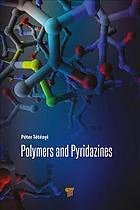Table Of ContentPolymers and Pyridazines
Polymers and Pyridazines
Péter Tétényi
Published by
Jenny Stanford Publishing Pte. Ltd.
Level 34, Centennial Tower
3 Temasek Avenue
Singapore 039190
Email: [email protected]
Web: www.jennystanford.com
British Library Cataloguing-in-Publication Data
A catalogue record for this book is available from the British Library.
Polymers and Pyridazines
All rights reserved. This book, or parts thereof, may not be reproduced in any form
Copyright © 2019 by Jenny Stanford Publishing Pte. Ltd.
or by any means, electronic or mechanical, including photocopying, recording
or any information storage and retrieval system now known or to be invented,
without written permission from the publisher.
For photocopying of material in this volume, please pay a copying fee through
the Copyright Clearance Center, Inc., 222 Rosewood Drive, Danvers, MA 01923,
USA. In this case permission to photocopy is not required from the publisher.
ISBN 978-981-4800-47-1 (Paperback)
ISBN 978-0-429-29646-8 (eBook)
Contents
Preface
Acknowledgment
ix
1. Introduction x1i
2. Experiments 3
H
2.1 Preparation of 4,5-Dichloro-2-
(polystyrylmethyl)-3(2 )-pyridazinone 5
(Attachment Reaction) 4
2.2 Preparation of 4,5-Dichloro-2-(4-
H
polystyryl(hydroxymethyl)phenyloxyethyl)-3
(2 )-pyridazinone 7 (Attachment Reaction) 5
H
2.3 Preparation of 4-Chloro-5-iodo-2-
(polystyrylmethyl)-3(2 )-pyridazinone 9
(Substitution Reaction) 6
2.4 Preparation of 4-Chloro-5-iodo-2-(4-
H
polystyryl(hydroxymethyl)phenyloxyethyl)-3
(2 )-pyridazinone 10 (Substitution Reaction) 8
H
2.5 Preparation of 4-Chloro-5-pyrrolidino-2-
(polystyrylmethyl)-3(2 )-pyridazinone 11
(Substitution Reaction) 9
2.6 Preparation of 4-Chloro-5-pyrrolidino-2-(4-
H
polystyryl(hydroxymethyl)phenyloxyethyl)-3
(2 )-pyridazinone 12 (Substitution Reaction) 10
H
2.7 Preparation of 4-Chloro-5-[(2-sulfanylethyl)
amino]-2-(polystyrylmethyl)-3(2 )-
pyridazinone 13 (Substitution Reaction) 12
2.8 Preparation of 4-Chloro-5-[(2-sulfanylethyl)
H
amino]-2-(4-polystyryl(hydroxymethyl)
phenyloxyethyl)-3(2 )-pyridazinone 15
(Substitution Reaction) 13
H
2.9 Preparation of 4-Chloro-5-hydrazino-2-
(polystyrylmethyl)-3(2 )-pyridazinone 16
(Substitution Reaction) 14
vi Contents
2.10 Preparation of 4-Chloro-5-hydrazino-2-(4-
H
polystyryl(hydroxymethyl)phenyloxyethyl)-3
(2 )-pyridazinone 17 (Substitution Reaction) 16
H
2.11 Preparation of 4-Chloro-2-(polystyrylmethyl)-3
(2 )-pyridazinone 18 (Elimination Reaction) 17
2.12 Preparation of 4-Chloro-2-(4-
H
polystyryl(hydroxymethyl)phenyloxyethyl)-3
(2 )-pyridazinone 19 (Elimination Reaction) 18
H
2.13 Preparation of 4-Chloro-5-[(2-sulfanylethyl)
amino]-3(2 )-pyridazinone 23 (Cleavage
Reaction) 20
H
2.14 Preparation of 4-Chloro-5-[(2-sulfanylethyl)
amino]-3(2 )-pyridazinone 23 by a Strong
H
Base (Cleavage Reaction) 21
2.15 Preparation of 4-Chloro-3(2 )-pyridazinone
26 (Cleavage Reaction) 23
H
2.16 Preparation of 4-Chloro-2-(2-hydroxyethyl)-5-
pyrrolidino-3(2 )-pyridazinone 28 (Cleavage
Reaction by Oxygen) 24
2.17 Preparation of 4-Chloro-2-(2-hydroxyethyl)-
3(2H)-pyridazinone 29 (Cleavage Reaction by
Oxygen) 26
H
2.18 Preparation of 4-Chloro-2-(2-hydroxyethyl)-
3(2 )-pyridazinone 29 (Cleavage Reaction by
1
Oxygen; Checking by H NMR) 27
H
2.19 Preparation of 4-Chloro-2-(2-hydroxyethyl)-
5-[(2-sulfanylethyl)amino]-3(2 )-pyridazinone
30 (Cleavage Reaction by Oxygen) 29
H
2.20 Preparation of 4-Chloro-5-iodo-2-
(2-hydroxyethyl)-3(2 )-pyridazinone 31
(Cleavage Reaction by Oxygen; Checking by
1
3. Results H NMR) 3313
3.1 Swelling Experiments 34
3.2 Attachment Reactions 39
3.3 Halogen Exchange Reactions 47
3.4 Substitution by Pyrrolidine 51
3.5 Side Reaction with a Strong Base 55
3.6 Alkylation Experiments by Cysteamine 55
Contents vii
3.7 Substitution Experiments by Hydrazine 58
3.8 Elimination Experiments of the Hydrazino
Derivatives 61
4. 3Co.9n clusCiolnea vage of the Supported Pyridazine Derivatives 6787
Bibliography 79
Index
81
Preface
In the past couple of years, a few articles have been published on
the solid-phase syn thesis of pyridazine derivatives. These methods
apply to intermediates weakly bound to polymers, as a result of
which the ester bond is cleaved easily, either during the ring closure
or right after it. We were going to develop a new strategy for poly-
mer-supported synthesis of pyrid a zine derivatives, with much
higher reaction rates, applying higher loading and much wider
reaction conditions due to the more stable at tachment. On the
basis of our research, a fundamental break through was achieved in
solid-phase heterocyclic chem is try. Only monofunctional reagents
were used for the attachment reaction to avoid the undesir ed do-
uble or polyreaction with the bifunctional hydrazine. The applied
2
N -al kyl at tachments pro ved to be stable during some nucleophilic
substitution reactions of the attached substrate but could be easily
cleaved by the end of the syn thesis via attack of electrophiles (BI3)
or strong acids (TFA). Dynamic swelling mea sure ments of the sup-
ported sub strates simulated the be havior of the polymers in real
reaction condit ions. Optimization was done for each reaction step,
and considerable accelera tion of the initial reaction rates was usually
reached un der prepa rative condit ions. Considerable widening of
the applied reaction conditions was reached due to stability of the
attachment. For example, it was stable within a pH range of 2–12
and up to a temperature of 170°C (approximate measured value).
Our new link er with the phenol ether struc tu ral element in it was
utilized as a mul ti det ach able linker, and more over, it was app lied as
a cosolvent in chemical reactions. Various comp arisons of the areas
of changing bands (FTIR) were carr ied out, with or without using
con trol reac tions, with or with out app lying elec tronic subtractions
of the standard ized spec tra. The results were eva luated according to
Dr. Péter Tétényi
weight changes measured as well as according to elemental analyses.
Department of Organic Chemistry, Pharmaceutical Faculty,
Semmelweis University, Hungary
2019

